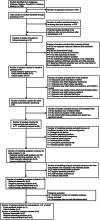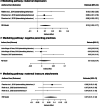Mediators and moderators in the relationship between maternal childhood adversity and children's emotional and behavioural development: a systematic review and meta-analysis
- PMID: 35730541
- PMCID: PMC9340854
- DOI: 10.1017/S0033291722001775
Mediators and moderators in the relationship between maternal childhood adversity and children's emotional and behavioural development: a systematic review and meta-analysis
Abstract
Maternal experiences of childhood adversity can increase the risk of emotional and behavioural problems in their children. This systematic review and meta-analysis provide the first narrative and quantitative synthesis of the mediators and moderators involved in the link between maternal childhood adversity and children's emotional and behavioural development. We searched EMBASE, PsycINFO, Medline, Cochrane Library, grey literature and reference lists. Studies published up to February 2021 were included if they explored mediators or moderators between maternal childhood adversity and their children's emotional and behavioural development. Data were synthesised narratively and quantitatively by meta-analytic approaches. The search yielded 781 articles, with 74 full-text articles reviewed, and 41 studies meeting inclusion criteria. Maternal mental health was a significant individual-level mediator, while child traumatic experiences and insecure maternal-child attachment were consistent family-level mediators. However, the evidence for community-level mediators was limited. A meta-analysis of nine single-mediating analyses from five studies indicated three mediating pathways: maternal depression, negative parenting practices and maternal insecure attachment, with pooled indirect standardised effects of 0.10 [95% CI (0.03-0.17)), 0.01 (95% CI (-0.02 to 0.04)] and 0.07 [95% CI (0.01-0.12)], respectively. Research studies on moderators were few and identified some individual-level factors, such as child sex (e.g. the mediating role of parenting practices being only significant in girls), biological factors (e.g. maternal cortisol level) and genetic factors (e.g. child's serotonin-transporter genotype). In conclusion, maternal depression and maternal insecure attachment are two established mediating pathways that can explain the link between maternal childhood adversity and their children's emotional and behavioural development and offer opportunities for intervention.
Keywords: Child emotional and behavioural development; ecological framework; maternal childhood adversity; mediator; moderator.
Conflict of interest statement
None.
Figures




Similar articles
-
Family-centred interventions for Indigenous early childhood well-being by primary healthcare services.Cochrane Database Syst Rev. 2022 Dec 13;12(12):CD012463. doi: 10.1002/14651858.CD012463.pub2. Cochrane Database Syst Rev. 2022. PMID: 36511823 Free PMC article.
-
Peer support interventions for parents and carers of children with complex needs.Cochrane Database Syst Rev. 2021 Dec 20;12(12):CD010618. doi: 10.1002/14651858.CD010618.pub2. Cochrane Database Syst Rev. 2021. PMID: 34923624 Free PMC article.
-
Parent training interventions for parents with intellectual disability.Cochrane Database Syst Rev. 2018 Jul 13;7(7):CD007987. doi: 10.1002/14651858.CD007987.pub3. Cochrane Database Syst Rev. 2018. PMID: 30004571 Free PMC article.
-
Group-based parent-training programmes for improving emotional and behavioural adjustment in 0-3 year old children.Cochrane Database Syst Rev. 2003;(1):CD003680. doi: 10.1002/14651858.CD003680. Cochrane Database Syst Rev. 2003. Update in: Cochrane Database Syst Rev. 2010 Mar 17;(3):CD003680. doi: 10.1002/14651858.CD003680.pub2. PMID: 12535483 Updated.
-
Parent-training programmes for improving maternal psychosocial health.Cochrane Database Syst Rev. 2004;(1):CD002020. doi: 10.1002/14651858.CD002020.pub2. Cochrane Database Syst Rev. 2004. Update in: Cochrane Database Syst Rev. 2012 Jun 13;(6):CD002020. doi: 10.1002/14651858.CD002020.pub3. PMID: 14973981 Updated.
Cited by
-
Intergenerational association of adverse childhood experiences and perinatal mental health in adult female offspring: evidence from the longitudinal grandmothers, mothers, and their Children's health study in China.Lancet Reg Health West Pac. 2025 May 14;59:101579. doi: 10.1016/j.lanwpc.2025.101579. eCollection 2025 Jun. Lancet Reg Health West Pac. 2025. PMID: 40487842 Free PMC article.
-
Links between mothers' ACEs, their psychopathology and parenting, and their children's behavior problems-A mediation model.Front Psychiatry. 2022 Dec 22;13:1064915. doi: 10.3389/fpsyt.2022.1064915. eCollection 2022. Front Psychiatry. 2022. PMID: 36620690 Free PMC article.
-
Maternal childhood maltreatment: associations to offspring brain volume and white matter connectivity.J Dev Orig Health Dis. 2023 Oct;14(5):591-601. doi: 10.1017/S2040174423000247. Epub 2023 Sep 21. J Dev Orig Health Dis. 2023. PMID: 37732425 Free PMC article.
-
The influence of early childhood education and care on the relation between early-life social adversity and children's mental health in the environmental influences for Child Health Outcomes Program.Dev Psychopathol. 2025 Aug;37(3):1628-1646. doi: 10.1017/S0954579424001822. Epub 2024 Dec 10. Dev Psychopathol. 2025. PMID: 39655664 Free PMC article.
-
Maternal child maltreatment and trajectories of offspring behavioural and emotional difficulties from age 4 to 7 years - results from a prospective birth cohort study.Eur Child Adolesc Psychiatry. 2025 Mar;34(3):1039-1050. doi: 10.1007/s00787-024-02534-3. Epub 2024 Jul 22. Eur Child Adolesc Psychiatry. 2025. PMID: 39039222 Free PMC article.
References
-
- Achenbach, T. M. (2011). Child behavior checklist. In Kreutzer J. S., DeLuca J., & Caplan B. (Eds.), Encyclopedia of clinical neuropsychology (pp. 546–552). New York, NY: Springer New York.
-
- Adams, J., Hillier-Brown, F. C., Moore, H. J., Lake, A. A., Araujo-Soares, V., White, M., & Summerbell, C. (2016). Searching and synthesising ‘grey literature’ and ‘grey information’ in public health: Critical reflections on three case studies. Systematic Reviews, 5(1), 164. 10.1186/s13643-016-0337-y. - DOI - PMC - PubMed
Publication types
MeSH terms
Grants and funding
LinkOut - more resources
Full Text Sources

